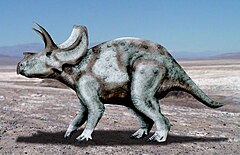- ↑ Sampson, S. D., Loewen, M. A., Farke, A. A., Roberts, E. M., Forster, C. A., Smith, J. A. & Titus, A. L. New Horned Dinosaurs from Utah Provide Evidence for Intracontinental Dinosaur Endemism. „PLoS ONE”. 5, s. e12292, 2010. DOI: 10.1371/journal.pone.0012292. (ang.).
- ↑ a b Robert M. Sullivan, Spencer G. Lucas: A New Chasmosaurine (Ceratopsidae, Dinosauria) from the Upper Cretaceous Ojo Alamo Formation (Naashoibito Member), San Juan Basin, New Mexico. W: Michael J. Ryan, Brenda J. Chinnery-Allgeier, David A. Eberth (red.): New Perspectives on Horned Dinosaurs. The Royal Tyrrell Museum Ceratopsian Symposium. Bloomington: Indiana University Press, 2010, s. 169-180. ISBN 978-0-253-35358-0.
- ↑ Williamson, T.E. & Weil, A. Metatherian mammals from the Naashoibito Member, Kirtland Formation, San Juan Basin, New Mexico and their biochronological and paleobiogeographic significance. „Journal of Vertebrate Paleontology”. 28, s. 803-815, 2008. DOI: 10.1671/0272-4634(2008)28%5B803:MMFTNM%5D2.0.CO;2. (ang.).
- ↑ Fassett, J.E., Heaman, L.M. & Simonetti, A. Direct U-Pb dating of Cretaceous and Paleocene dinosaur bones, San Juan Basin, New Mexico. „Geology”. 39, s. 159-162, 2011. DOI: 10.1130/G31466.1. (ang.).
- ↑ a b Nicholas R. Longrich. Titanoceratops ouranos, a giant horned dinosaur from the Late Campanian of New Mexico. „Cretaceous Research”. 32 (3), s. 264-276, 2011. DOI: 10.1016/j.cretres.2010.12.007. (ang.).
